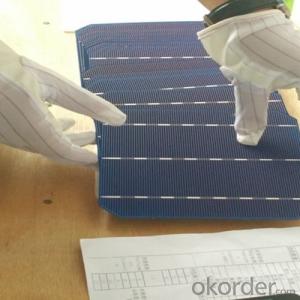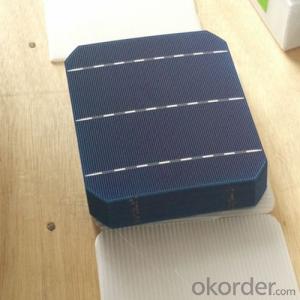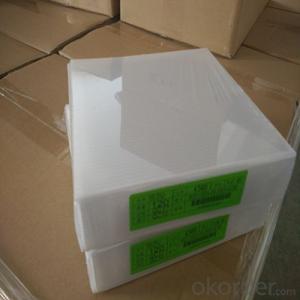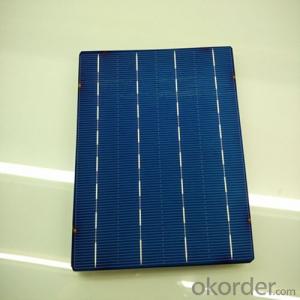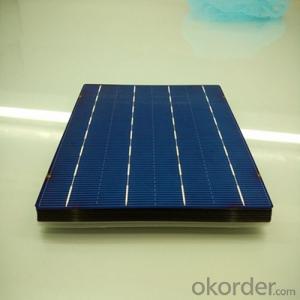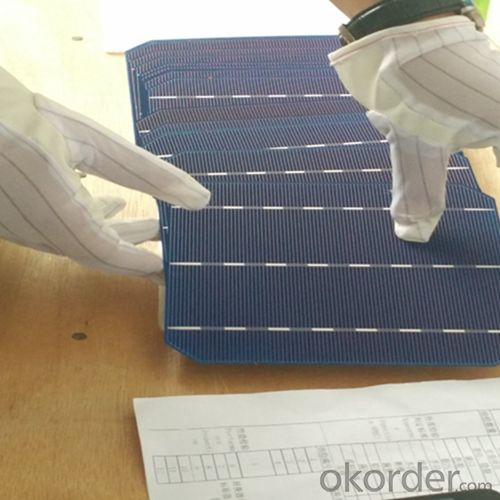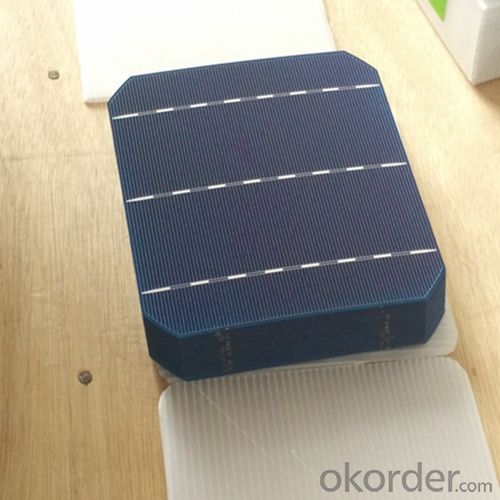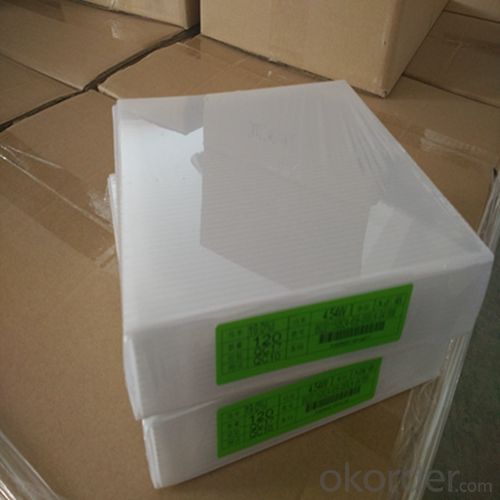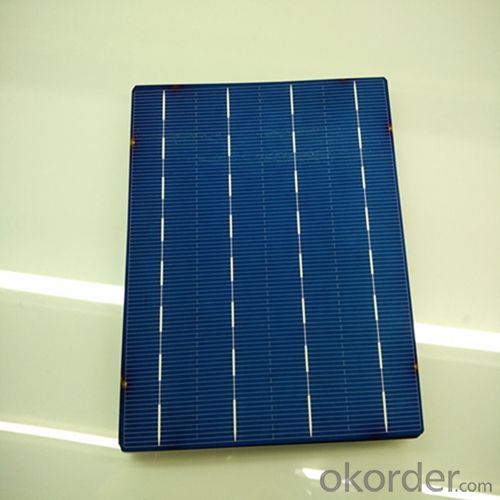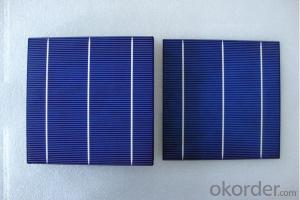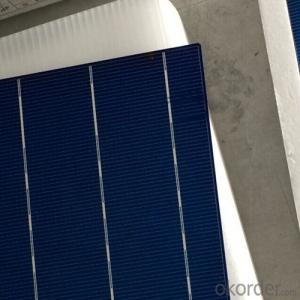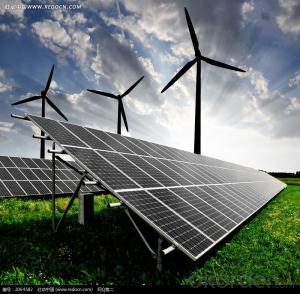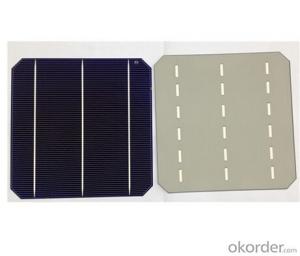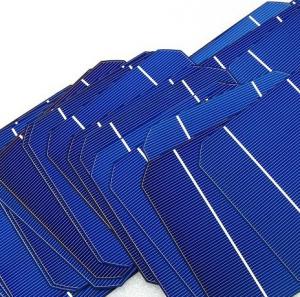Silicon Based Solar Cells - Mono 156x156mm2 Solar Cells Made in China
- Loading Port:
- Shanghai
- Payment Terms:
- TT OR LC
- Min Order Qty:
- 6000 watt
- Supply Capability:
- 6000000 watt/month
OKorder Service Pledge
OKorder Financial Service
You Might Also Like
The operation of a photovoltaic (PV) cell requires 3 basic attributes:
The absorption of light, generating either electron-hole pairs or excitons.
The separation of charge carriers of opposite types.
The separate extraction of those carriers to an external circuit.
In contrast, a solar thermal collector supplies heat by absorbing sunlight, for the purpose of either direct heating or indirect electrical power generation from heat. A "photoelectrolytic cell" (photoelectrochemical cell), on the other hand, refers either to a type of photovoltaic cell (like that developed by Edmond Becquerel and modern dye-sensitized solar cells), or to a device that splits water directly into hydrogen and oxygen using only solar illumination.Characteristic of Mono 156X156MM2 Solar Cells
You are gaining energy independence - add battery backup power for even greater energy security
The cost of electricity is only going to rise – insure against that rising cost
Adaptive cells change their absorption/reflection characteristics depending to respond to environmental conditions. An adaptive material responds to the intensity and angle of incident light. At the part of the cell where the light is most intense, the cell surface changes from reflective to adaptive, allowing the light to penetrate the cell. The other parts of the cell remain reflective increasing the retention of the absorbed light within the cell.[67]
In 2014 a system that combined an adaptive surface with a glass substrate that redirect the absorbed to a light absorber on the edges of the sheet. The system also included an array of fixed lenses/mirrors to concentrate light onto the adaptive surface. As the day continues, the concentrated light moves along the surface of the cell. That surface switches from reflective to adaptive when the light is most concentrated and back to reflective after the light moves along
Mechanical data and design
Format | 156mm x 156mm±0.5mm |
Thickness | 210μm±40μm |
Front(-) | 1.5mm bus bar (silver),blue anti-reflection coating (silicon nitride) |
Back (+) | 2.5mm wide soldering pads (sliver) back surface field (aluminium) |
Temperature Coefficient of Cells
Voc. Temp.coef.%/K | -0.35% |
Isc. Temp.coef .%/K | +0.024%/K |
Pm.Temp.coef. %/K | -0.47%/K |
Electrical Characteristic
Effiency(%) | Pmpp(W) | Umpp(V) | Impp(A) | Uoc(V) | Isc(A) | FF(%) |
18.35 | 4.384 | 0.526 | 8.333 | 0.63 | 8.877 | 78.39% |
18.20 | 4.349 | 0.526 | 8.263 | 0.63 | 8.789 | 78.54% |
18.05 | 4.313 | 0.525 | 8.216 | 0.63 | 8.741 | 78.32% |
17.90 | 4.277 | 0.524 | 8.161 | 0.625 | 8.713 | 78.04% |
17.75 | 4.241 | 0.523 | 8.116 | 0.625 | 8.678 | 77.70% |
17.60 | 4.206 | 0.521 | 8.073 | 0.625 | 8.657 | 77.36% |
17.45 | 4.170 | 0.519 | 8.039 | 0.625 | 8.633 | 76.92% |
17.30 | 4.134 | 0.517 | 8.004 | 0.625 | 8.622 | 76.59% |
17.15 | 4.096 | 0.516 | 7.938 | 0.625 | 8.537 | 76.80% |
17.00 | 4.062 | 0.512 | 7.933 | 0.625 | 8.531 | 76.18% |
16.75 | 4.002 | 0.511 | 7.828 | 0.625 | 8.499 | 75.34% |
16.50 | 3.940 | 0.510 | 7.731 | 0.625 | 8.484 | 74.36% |
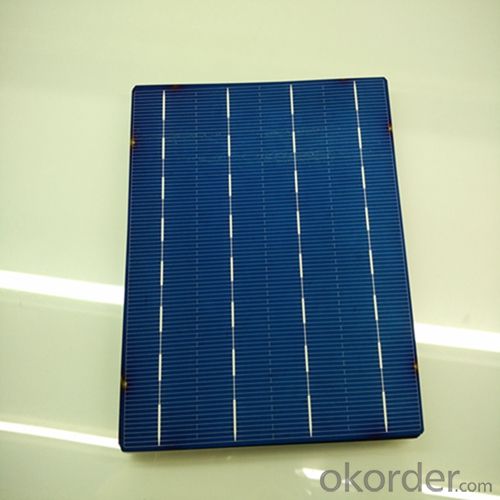
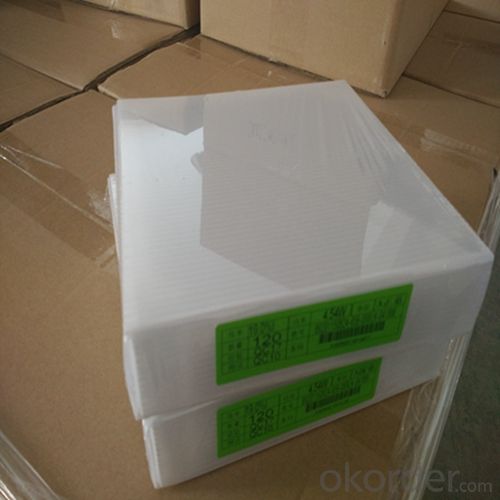
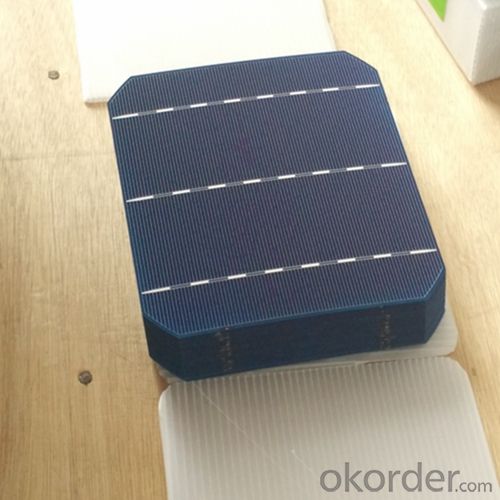
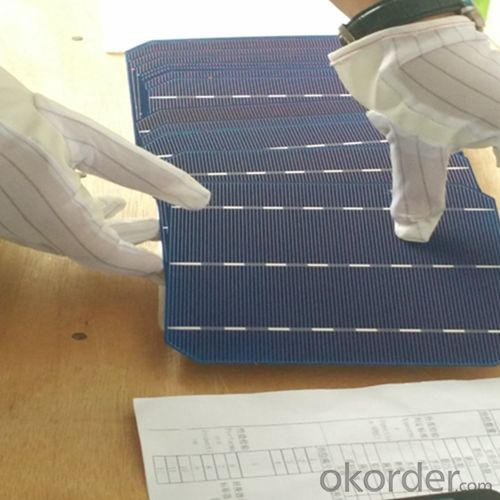
 FAQ
FAQ
Q: What price for each watt?
A: It depends on the quantity, delivery date and payment terms, generally Large Quantity and Low Price
Q: What is your size for each module? Can you tell me the Parameter of your module?
A: We have different series of panels in different output, both c-Si and a-Si. Please take the specification sheet for your reference.
Q: What is your size for each module? Can you tell me the Parameter of your module?
A: We have different series of panels in different output, both c-Si and a-Si. Please take the specification sheet for your reference.
- Q: Can solar cells be used in recreational vehicles?
- Yes, solar cells can be used in recreational vehicles (RVs). Solar panels can be installed on the roof of an RV to harness sunlight and convert it into electricity, which can then be used to power various appliances and systems within the vehicle. This allows RV owners to enjoy the benefits of renewable energy while traveling and reduces the need for traditional power sources.
- Q: What is a monocrystalline Silicon Solar Cells?
- Compared to the other kinds of solar cells made in the world, the Monocrystalline Silicon Solar Cells are much more efficient and less cost-saving than the other kinds of solar cells.
- Q: What should I know about the Crystalline silicon photovoltaic cells?
- Crystalline silicon photovoltaic cells, known as cSi PV, are made of silicon atoms connected to one another to form a crystal lattice. This lattice comprises the solid material that forms the photovoltaic (PV) cell's semiconductors.
- Q: Can solar cells be used to power remote wildlife monitoring systems?
- Yes, solar cells can be used to power remote wildlife monitoring systems. Solar cells convert sunlight into electricity, providing a reliable and renewable source of power for monitoring equipment in areas without access to the grid. This makes them an ideal solution for remote wildlife monitoring systems, allowing for continuous data collection and monitoring while minimizing the need for maintenance and manual power supply.
- Q: Can solar cells be used in powering medical devices?
- Yes, solar cells can be used to power medical devices. Solar cells can convert sunlight into electricity, which can then be used to directly power or recharge batteries of various medical devices such as pacemakers, insulin pumps, and portable diagnostic equipment. This renewable energy source offers a sustainable and efficient solution for powering medical devices, especially in remote or resource-limited areas where access to electricity may be limited.
- Q: Do solar cells work in cloudy weather?
- Yes, solar cells can still generate electricity in cloudy weather, although their efficiency may be reduced compared to direct sunlight.
- Q: Can solar cells be used in swimming pool heating?
- Yes, solar cells can be used in swimming pool heating. Solar panels can capture sunlight and convert it into energy, which can then be used to heat the pool water. This renewable energy source is environmentally friendly and can help reduce energy costs associated with pool heating.
- Q: Are solar cells environmentally friendly?
- Yes, solar cells are environmentally friendly. They generate electricity by harnessing the sun's energy, which is a clean and renewable source of power. Solar energy production does not produce greenhouse gas emissions, air pollution, or create hazardous waste. Additionally, solar cells have a long lifespan and can be recycled at the end of their life, minimizing their environmental impact.
- Q: How do solar cells compare to other renewable energy sources?
- Solar cells have several advantages over other renewable energy sources. They are highly versatile and can be installed in various locations, from rooftops to large-scale solar farms. Solar energy is abundant and accessible in most parts of the world, making it a reliable and widely available source of power. Additionally, solar cells have a low environmental impact, as they produce electricity without emitting greenhouse gases or other pollutants. Finally, solar energy is becoming increasingly cost-effective, with declining prices for solar panels and improved efficiency. However, solar cells do have limitations, such as dependence on sunlight availability and the need for large areas of land for large-scale installations. Nonetheless, their numerous advantages make solar cells a valuable and promising renewable energy option.
- Q: How do solar cells perform in regions with high levels of dust and sandstorms?
- Solar cells can be affected by dust and sandstorms in regions with high levels of such conditions. The accumulation of dust particles on the surface of solar panels can reduce their efficiency by blocking sunlight and creating a layer of insulation. Regular maintenance, such as cleaning the panels to remove dust and debris, is crucial to ensure optimal performance. Additionally, advancements in solar panel designs, such as anti-reflective coatings and self-cleaning mechanisms, are being developed to mitigate the impact of dust and sandstorms on solar cell performance in these regions.
Send your message to us
Silicon Based Solar Cells - Mono 156x156mm2 Solar Cells Made in China
- Loading Port:
- Shanghai
- Payment Terms:
- TT OR LC
- Min Order Qty:
- 6000 watt
- Supply Capability:
- 6000000 watt/month
OKorder Service Pledge
OKorder Financial Service
Similar products
Hot products
Hot Searches
Related keywords
